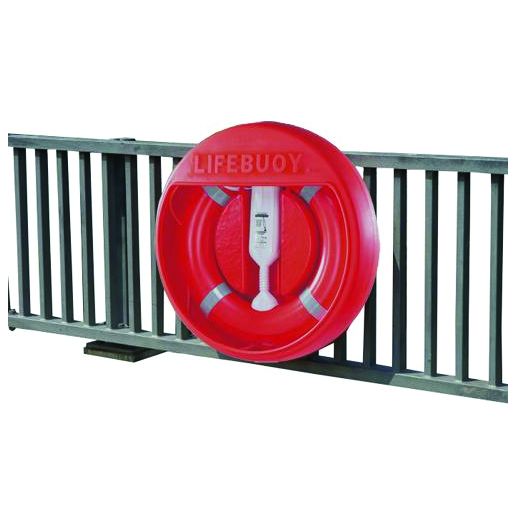-

Rail Mounted Lifebuoy Housing - Single With Brackets
From £303.90 To £334.99Supplied in: Single -

Wall Mounted Polyethylene Lifebuoy Housing - Single
From £265.99 To £310.00Supplied in: Single -
Promotion

Post-Mounted Polyethylene Lifebuoy Housing - Single
From £359.39 To £394.39
From £337.00 To £394.39
Supplied in: Single -
Promotion

Lifebuoys with Reflective Tape
From £45.09 To £48.89
From £39.60 To £41.15
Supplied in: Single -
Promotion

Encapsulated Floating Lifeline. Orange Line For Lifebuoy
From £34.59 To £42.09
From £28.95 To £35.70
Supplied in: Single -

Telescopic Boat Hook
£25.49Supplied in: Single -

Orange Floating LIfebuoy Lifeline - Single 30m Line
£25.60Supplied in: Single -

Rescue Throw Line Bag Cabinets
From £72.19 To £214.69Supplied in: Single -

Life Jacket
£51.19Supplied in: Single -
Promotion

Orange Lifebuoy Housing Polyethylene Single Covers
From £88.99 To £99.39
From £82.65 To £88.99
Supplied in: Single -
Promotion

Lifebuoys without Reflective Tape
£40.99
£35.95
Supplied in: Single -

Lifebuoy Support Brackets
£30.69Supplied in: Single
Water Safety
Need help?
 What's the difference between lifebuoys and throwbags?
Accidents can occur in any workplace and many incidents, especially when near bodies of water, can be life-threatening to you or your employees. Water safety devices can be efficient tools in the workplace, and prevent serious injury or death. Depending on your circumstances, they may also be necessary to ensure you comply with health and safety regulations and laws.
What's the difference between lifebuoys and throwbags?
Accidents can occur in any workplace and many incidents, especially when near bodies of water, can be life-threatening to you or your employees. Water safety devices can be efficient tools in the workplace, and prevent serious injury or death. Depending on your circumstances, they may also be necessary to ensure you comply with health and safety regulations and laws.
From lifebuoys to throwbags, these devices are essential to every organisation close to a river, lake, dam or port and can be the easiest and most cost-effective method of resolving water-related incidents. With several options available for storing and displaying buoys and lines, these devices can be placed anywhere and will play a huge part in bringing about a positive outcome to any water accident.
Also discover:
PPEHead protectionSafety glovesFall arrest system Eye ProtectionEar defendersBreathing protectionSafety footwearLife jackets
Water Rescue Equipment Buying Guide
Our product line offers everything your organisation will need to resolve water safety issues, as well as the storage and display of these devices.
As per UK health and safety regulations, water safety devices need not only to be present in all relevant workplaces but you also need to ensure the device is clearly visible, easily accessible and is in proper working order.
Lifebuoys and throwbags should form the basis of your water safety provisions; they are ideal for most workplaces and water accidents.
Life Preservers for Essential Water Safety
The lifebuoy, also known as a life preserver, is the most recognisable water safety device, with centuries of use in ships and boats and at coastal, lakeside or dam locations. The devices are usually located close to deep water bodies with the potential to drown individuals. They are not recommended for use in domestic or smaller commercial swimming pools.The use of the device is simple and requires minimal previous knowledge or skill to operate. When in a critical water-related accident situation, an employee would simply throw the lifebuoy to the person who is in danger in a body of water. The buoyant nature of the device — as its name suggests — ensures the individual can float and remain above the water while they are transported to land. The lifebuoy is generally attached to a connecting line, held by the rescuer, which enables the person to be effectively pulled to shore or to a nearby boat or ship.
The device features the typical ring or horseshoe structure. It is generally filled with foam, has a lightweight plastic exterior with a hollow interior or is an inflatable device. The size, style and composition of the lifebuoy will depend on your needs, the surrounding environment and the space requirements of the device.
Lifebuoys are usually available manufactured or painted with bright designs and can also be adorned with reflective tape or fluorescent signage.
Throw Rope - Saving Lives When Space is Limited
For a more easily portable water safety device or for safety in confined spaces, throwbags are a popular choice for many organisations and individuals. The throwbag is the most common safety device in kayaks, canoes and other small, outdoor water recreational devices.The throwbag comprises a length of rope, generally measuring around 25 metres, which is stored in a lightweight bag. When thrown, the rope unravels and is then caught by the person in difficulty. The structure and placing of the rope in the bag ensures the rope can travel long distances, similar to the style of a fishing reel.
